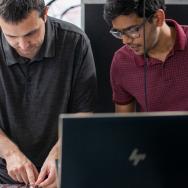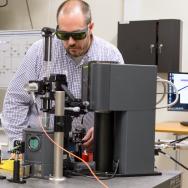When the quantum internet arrives, researchers predict it will shift the computing landscape on a scale unseen in decades. In their estimation, it will make hacking a thing of the past. It will secure global power grids and voting systems. It will enable nearly limitless computing power and allow users to securely send information across vast distances.
But for Tian Zhong, assistant professor at the Pritzker School of Molecular Engineering (PME) at the University of Chicago, the most tantalizing benefits of the quantum internet have yet to be imagined.
Zhong is a quantum engineer working to create this new global network. In his mind, the full impact of the quantum internet may only be realized after it’s been built. To understand his work and why the United States is spending $625 million on the new technology, it helps to consider the science behind it: quantum mechanics.
Quantum mechanics is a theory created to explain fundamental properties of matter, particularly on the subatomic scale. Its roots trace back to the late 19th and early 20th century, when scientists tried to explain the unusual nature of light, which behaves as both a wave and a particle. In the hundred years since then, physicists have learned a great deal, particularly concerning the strange behavior of subatomic particles.
They’ve learned, for example, that some subatomic particles have the ability to be in two states at the same time, a principle called superposition. Another such principle is entanglement, which is the ability of two particles to “communicate” instantaneously despite being separated by hundreds of miles.
Over time, scientists have found ways to manipulate those principles, entangling particles at will or controlling an electron’s spin. That new control allows researchers to encode, send, and process information using subatomic particles—laying the foundations of quantum computing and the quantum internet.
At the moment, both technologies are still hampered by certain physical limitations—quantum computers, for example, need to be kept in giant sub-zero freezers—but researchers like Zhong are optimistic those limitations will be resolved in the near future.
“We’re at a juncture where this is no longer science fiction,” Zhong said. “More and more, it’s looking like this technology will emerge from laboratories any day, ready to be adopted by society.”
The right tools for the job
Zhong’s research focuses on the hardware needed to make the quantum internet a reality, things like quantum chips that encrypt and decrypt quantum information, and quantum repeaters that relay information across network lines. To create that hardware, Zhong and his team work on the subatomic scale, using individual atoms to hold information and single photons to transmit it through optic cables.
Zhong’s current work centers on finding ways to fight against quantum decoherence, which is when information stored on a quantum system degrades to the point that it’s no longer retrievable. Decoherence is an especially difficult obstacle to overcome because quantum states are extremely sensitive and any outside force—be it heat, light, radiation, or vibration—can easily destroy it.
Most researchers address decoherence by keeping quantum computers at a temperature near absolute zero. But the instant any quantum state is transmitted outside the freezer, say on a network line, it begins to break down within a few microseconds, severely limiting the potential for expansive interconnectivity.
To guard against quantum decoherence, Zhong’s lab is developing a system for temporarily storing and relaying quantum information using rare-earth atoms. Specifically, he’s working with erbium, a rare earth element that has unique electronic properties. Zhong uses it to capture and store quantum information within shielded atomic states, effectively creating quantum memory. In that way, he’s able to keep the information viable for milliseconds—more than enough time to re-transmit it through a network. Using this approach, Zhong is now developing quantum repeaters that will extend the reach of quantum communication networks toward a global scale.
“We’re creating the building blocks of the quantum internet and this repeater is one of them,” Zhong said. “The technology has all the bits and pieces ready, and the next step is assembling the system. People involved in this project have discussed a roadmap of when that could happen, and we think it can be done in the next five to ten years.”
Expanding the quantum future
In addition to his goal of connecting the world’s quantum computers, Zhong has a strong commitment to educating the next generation of quantum engineers. To that end, Zhong has created new course offerings in quantum science at UChicago and he’s been an active partner in PME’s STAGE lab, which explores how art can help convey scientific concepts to a broad audience.
In January 2020, Zhong was awarded $500,000 through the National Science Foundation’s Faculty Early Career Development Program to fund his research and educational efforts, including the TeachQuantum program, which trains public high school teachers how to incorporate quantum science into their lesson plans and aims to engage students who are traditionally underrepresented in the sciences.
The program’s inaugural cohort started in June 2021, meeting with PME faculty to develop new quantum-inspired activities for their classrooms. Participants and faculty will continue to meet periodically throughout the school year to share their results. The University now plans to expand the program to include more teachers at UChicago, University of Illinois at Urbana-Champaign, and University of Wisconsin-Madison.
“We believe as educators it’s our job to expose students to and train them on quantum concepts very early on,” said Zhong. “That’s why we design programs targeted at high school students and the general public. The goal is not to lecture on quantum physics, but to create an engaging experience for them to appreciate the importance and future potentials of quantum technologies and their impact on society.”
As Zhong looks to the future, he makes clear that while some benefits of the quantum internet are known, some may not be realized until after the technology is developed. That’s been true for other technological breakthroughs like the modern internet, which has spawned numerous applications that few could have imagined during the early years of its development.
What does Zhong think will happen when the quantum internet is established?
“Something very exciting,” he said. “With classical computers, if you want to double your computation power, you have to double the amount of hardware. But in quantum computing, you just need to add one qubit. With sixty qubits you can rival the world’s fastest supercomputer. So if you connect millions of quantum computers? That computational power will open doors to things we cannot even imagine.”
—This story was first published by the Pritzker School of Molecular Engineering.

